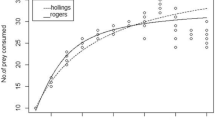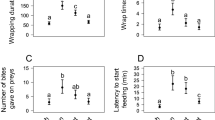Abstract
Feeding decisions under predation risk can be a key in the life of scavenger organisms, and tuned recognition of predation alarm cues and flexibility in the response are fundamental. The effect of injured conspecifics on the response behavior of the whelk Buccinanops globulosum to feeding opportunities was experimentally evaluated in a Patagonian Bay (40°45′S, 64°56′W, Argentina) in September 2010. The effect of sex, size, body condition, or starvation on anti-predatory behavior was assessed. The number of B. globulosum feeding on carrion was reduced by half when damaged conspecifics were present. Smaller, lighter, and starved individuals responded less to the presence of damaged conspecifics. These results indicate that, under natural conditions, feeding avoidance after detecting damaged conspecifics is a common and important anti-predatory strategy of B. globulosum and show that morphology and starvation are significant factors in the context of the trade-off between feeding and avoiding predation risk.



Similar content being viewed by others
References
Alexander JE Jr, Covich AP (1991) Predation risk and avoidance behavior in two freshwater snails. Biol Bull 180:387–393
Avaca MS (2011) Estudio comparativo de la estructura demográfica y de las características biológicas del caracol Buccinanops globulosus en los golfos norpatagónicos. Tesis Doctoral de la Universidad Nacional del Sur, UNS, Bahía Blanca
Avaca MS, Narvarte M, Martín PR (2010) Description of the radula of Buccinanops globulosum (Neogastropoda, Nassaridae), and an assessment of its variability in Patagonian gulfs. Malacologia 53:175–184
Blum MS (1969) Alarm pheromones. Annu Rev Entomol 14:57–80
Bordeau PE (2010) An inducible morphological defense is a passive by-product of behaviour in a marine snail. Proc R Soc B 277:455–462
Britton JC, Morton B (1994) Marine carrion and scavengers. Oceanogr Mar Biol Annu Rev 32:369–434
Brookers JI, Rochette R (2007) Mechanisms of plastic phenotypic response: predator-induced shell thickening in the intertidal gastropod Littorina obtusata. J Evol Biol 20:1015–1027
Brown GE, Adrian JC, Naderi NT, Harvey MC, Kelly JM (2003) Nitrogen oxides elicit antipredator responses in juvenile channel catfish, but not in convict cichlids or rainbow trout: conservation of the ostariophysan alarm pheromone. J Chem Ecol 29:1781–1796
Chivers DP, Smith RJF (1998) Chemical alarm signaling in aquatic predator-prey systems: a review and prospectus. Ecoscience 5:338–352
Chivers DP, Kiesecker JM, Marco A, DeVito J, Anderson MT, Blaustein AR (2001) Predator-induced life history changes in amphibians: egg predation induces hatching. Oikos 92:135–142
Cotton PA, Rundle SD, Smith KE (2004) Trait compensation in marine gastropods: shell shape, avoidance behavior, and susceptibility to predation. Ecology 85:1581–1584
Crowl TA, Covich AP (1990) Predator-induced life-history shifts in a freshwater snail. Science 247:949–951
Cuthill IC, Houston AI (1997) Managing time and energy. In: Krebs JR, Davies NB Jr (eds) Behavioural ecology: an evolutionary approach. Blackwell, Oxford
Daleo P, Escapa M, Isacch JP, Ribeiro P, Iribarne O (2005) Trophic facilitation by the oystercatcher Haematopus palliatus Temminick on the scavenger snail Buccinanops globulosum Kiener in a Patagonian bay. J Exp Mar Biol Ecol 325:27–34
Daleo P, Silliman B, Alberti J, Escapa M, Canepuccia A, Peña N, Iribarne O (2009) Grazer facilitation of fungal infection and the control of plant growth in south-western Atlantic salt marshes. J Ecol 97:781–787
Davenport J, Moore PG (2002) Behavioural responses of the netted dogwhelk Nassarius reticulatus to olfactory signals derived from conspecifics and nonconspecific carrion. J Mar Biol Assess UK 82:967–969
Dewitt TJ, Sih A, Hucko JA (1999) Trait compensation and cospecialization in a freshwater snail: size, shape and antipredator behaviour. Anim Behav 58:397–407
Ferner MC, Smee DL, Chang Y (2005) Cannibalistic crabs respond to the scent of injured conspecifics: danger or dinner? Mar Ecol Prog Ser 300:193–200
Garcia GO, Isacch JP, Gomes Laich A, Albano M, Favero M, Cardoni DA, Luppi T, Iribarne O (2010) Foraging behaviour and diet of the American oystercatcher in a Patagonian intertidal area affected by nutrient loading. Emu 110:146–154
González PM, Piersma T, Verkuil Y (1996) Food, feeding, and refuelling of Red Knots during northward migration at San Antonio Oeste, Río Negro, Argentina. J Field Ornithol 67:575–591
Hartman EJ, Abrahams MV (2000) Sensory compensation and the detection of predators: the interaction between chemical and visual information. Proc Roy Soc B 267:571–575
Iribarne OO (1990) Use of shelter by the small Patagonian octopus Octopus tehuelchus: availability, selection and effects on fecundity. Mar Ecol Prog Ser 66:251–258
Isacch JP, Costa CBS, Rodrıguez-Gallego L, Conde D, Escapa M, Gagliardini DA, Iribarne OO (2006) Distribution of saltmarsh plant communities associated with environmental factors along a latitudinal gradient in the south-west Atlantic coast. J Biogeogr 33:888–900
Jacobsen HP, Stabell OB (2004) Antipredator behaviour mediated by chemical cues: the role of conspecific alarm signalling and predator labelling in the avoidance response of a marine gastropod. Oikos 104:43–50
Kats LB, Dill LM (1998) The scent of death: chemosensory assessment of predation risk by prey animals. Ecoscience 5:361–394
Large SI, Smee DL (2010) Type and nature of cues used by Nucella lapillus to evaluate predation risk. J Exp Mar Biol Ecol 396:10–17
Lima SL, Dill LM (1990) Behavioral decisions made under the risk of predation: a review and prospectus. Can J Zool 68:619–640
Magurran AE, Irving PW, Henderson PA (1996) Is there a fish alarm pheromone? A wild study and critique. Proc Roy Soc B 229:1551–1556
McCormick MI, Larson JK (2007) Field verification of the use of chemical alarm cues in a coral reef fish. Coral Reefs 26:571–576
McKillup SC, Butler AJ (1979) Modification of egg production and packaging in response of food availability by Nassarius pauperatus. Oecologia 43:222–231
McKillup SC, McKillup RV (1994) The decision to feed by a scavenger in relation to the risks of predation and starvation. Oecologia 97:41–48
McKillup SC, McKillup RV (1997) The effect of supplemental feeding on the growth of an intertidal scavenger. Mar Ecol Prog Ser 148:109–114
Morton B, Chan K (1999) Hunger rapidly overrides the risk of predation in the subtidal scavenger Nassarius siquijorensis (Gastropoda: nassariidae): an energy budget and a comparison with the intertidal Nassarius festivus in Hong Kong. J Exp Mar Biol Ecol 240:213–228
Morton B, Jones DS (2003) The dietary preferences of a suite of carrion-scavenging gastropods (Nassariidae, Buccinidae) in Princess Royal Harbour, Albany, Western Australia. J Moll Stud 69:151–156
Narvarte M, Willers V, Avaca S, Echave ME (2008) Population structure of the snail Buccinanops globulosum (Prosobranchia, Nassariidae) in San Matías Gulf, Patagonia Argentina: isolated enclaves? J Sea Res 60:144–150
Pfeiffer W (1977) Distribution of fright reaction and alarm substance cells in fishes. Copeia 1977:653–665
Rochette R, Himmelman JH (1996) Does vulnerability influence trade-offs made by whelks between predation risk and feeding opportunities? Anim Behav 52:783–794
Rochette R, Tétreault F, Himmelman JH (2001) Aggregation of whelks, Buccinum undatum, near feeding predators: the role of reproductive requirements. Anim Behav 61:31–41
Rundle SD, Brönmark C (2001) Inter- and intraspecific trait compensation of defence mechanisms in freshwater snails. Proc Roy Soc Lon B 268:1463–1468
Rundle SD, Spicer JI, Coleman RA, Vasper J, Soane J (2004) Environmental calcium modifies induced defenses in snails. Proc Roy Soc Lond B 271:S67–S70
Scarabino V (1977) Moluscos del Golfo San Matías (Prov. de Río Negro, Rca. Argentina). Inventario y claves para su identificación. Comunic Soc Malacol Uruguay 4:177–297
Schoeppner NM, Relyea RA (2005) Damage, digestion, and defence: the roles of alarm cues and kairomones for inducing prey defenses. Ecol Lett 8:505–512
Soto RE, Castilla JC, Bozinovic F (2005) The impact of physiological demands on foraging decisions under predation risk: a test with the whelk Acanthina monodon. Ethology 111:1044–1049
Spitze K (1992) Predator-mediated plasticity of prey life history and morphology: Chaoborus americanus predation on Daphnia pulex. Am Nat 139:229–247
Trussell GC (1996) Phenotypic plasticity in an intertidal snail: the role of a common crab predator. Evolution 50:448–454
Trussell GC, Nicklin MO (2002) Cue sensitivity, inducible defense, and trade-offs in a marine snail. Ecology 83:1635–1647
Trussell CC, Smith LD (2000) Induced defenses in response to an invading crab predator: an explanation of historical and geographic phenotypic change. Proc Natl Acad Sci USA 97:2123–2127
Turner AM (2008) Predator diet and prey behaviour: freshwater snail discriminate among closely related prey in a predator’s diet. Anim Behav 76:1211–1217
Wisenden BD, Vollbrecht KA, Brown JL (2004) Is there a fish alarm cue? Affirming evidence from a wild study. Anim Behav 67:59–67
Zar JH (1999) Biostatistical analysis, 4th edn. Prentice-Hall, Upper Saddle River
Acknowledgments
We thank Dr. J.P. Grassle and two anonymous referees for valuable comments in the manuscript. This project was supported by grants from the Universidad Nacional de Mar del Plata, the Fundación Antorchas, CONICET and ANPCyT (all granted to O.I.) and PICT CONAE-CONICET 04/2010 (granted to M.N.). M.S.A was supported by a Postdoctoral scholarship from CONICET (Argentina).
Author information
Authors and Affiliations
Corresponding author
Additional information
Communicated by J. P. Grassle.
Rights and permissions
About this article
Cite this article
Daleo, P., Alberti, J., Avaca, M.S. et al. Avoidance of feeding opportunities by the whelk Buccinanops globulosum in the presence of damaged conspecifics. Mar Biol 159, 2359–2365 (2012). https://doi.org/10.1007/s00227-012-2020-8
Received:
Accepted:
Published:
Issue Date:
DOI: https://doi.org/10.1007/s00227-012-2020-8




